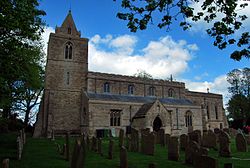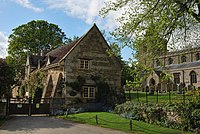Upper Hambleton
| Hambleton | |
| Rutland | |
|---|---|
 St Andrews, Upper Hambledon | |
| Location | |
| Grid reference: | SK900075 |
| Location: | 52°39’32"N, -0°40’16"W |
| Data | |
| Population: | 140 (2001) |
| Post town: | Oakham |
| Postcode: | LE15 |
| Dialling code: | 01562 |
| Local Government | |
| Council: | Rutland |
| Parliamentary constituency: |
Rutland and Melton |


Upper Hambleton or just Hambleton is a village in Rutland. It stands on a ridge of land, the Hambleton, peninsula, surrounded on three sides by Rutland Water
Upper Hambleton is about two miles east of Oakham and in 2001 it had a population of 140. Before the construction of the reservoir later named Rutland Water in the 1970s, the village was surrounded by farmland. The reservoir however filled the valleys to either side and submerged their villages, since when Upper Hambleton has been closed off on three sides by the waters, leaving its ridge as a peninsula. There is only one road out of the village to the rest of the world. The road in the opposite direction is closed as a public road, now serving only a few houses and farms before its original course runs into the water.
The village contains the 12th century Parish Church, St Andrew, a pub and a hotel and restaurant.
There is a wonderful view across to Burley House from the north side of the village and from the south one can see across the Water to the sailing club at Edith Weston on the far shore. The track around the peninsula along the lakeside takes walkers and cyclists through bluebell woods.
Hambleton Hall, now a hotel, was built in 1881 as a hunting lodge by Walter Marshall. He left it to his sister, Eva Astley Paston Cooper, a socialite who gathered a salon including Noël Coward, Malcolm Sargent and Charles Scott-Moncrieff. Coward wrote Hay Fever while staying in the village.
Parish church
The Church of St Andrew was built in the 12th century and has since been much enlarged. It has an original Norman south doorway
The church was extensively restored during the 19th century, at which time it gained fine stained glass windows created mainly by J Egan.
By the south side of the churchyard stands a sixteenth century priest house [1].
Nether Hambleton and Middle Hambleton
The parish of Hambleton originally included the settlements of 'Upper Hambleton, Middle Hambleton and Nether Hambleton. The latter two have now been submerged by the construction of Rutland Water.
The Old Hall in Middle Hambleton survives, now situated on the water's edge. It was built in 1611 in the then contemporary Jacobean style, and is all that remains of the village.